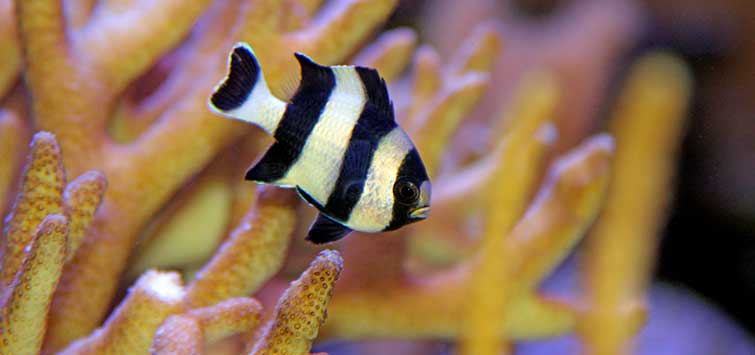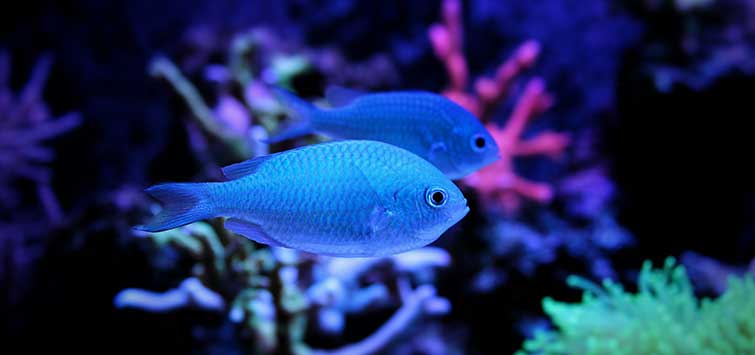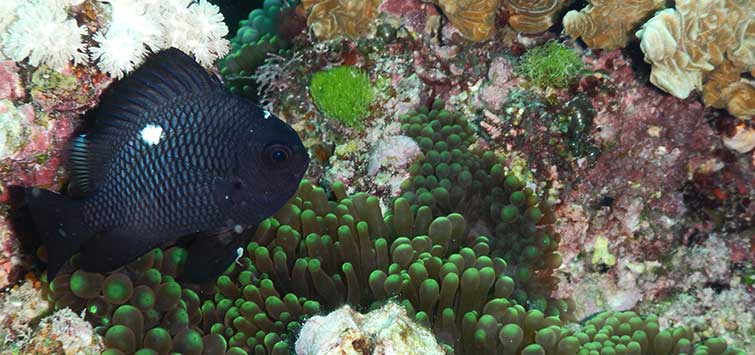Damsels in My Aquarium
Author: Bob Goemans
Damsels are hardy, lively, and colorful marine fish, but the territorial nature of many species belies their relatively small size.
Damsel Basics
Most damselfishes are extremely hardy, colorful, lively, disease resistant, inexpensive, and will eat most typical aquarium foods. Those are their good points. Unfortunately some hobbyists, especially those new to the hobby, don’t realize how territorial some species are and how important it is to consider the order in which they should be placed in the aquarium (i.e., first fish, in-between additions, or the last fish to be added).
Over the years I’ve kept many different species, and I have developed some personal preferences as to what to keep and what I wouldn’t want to try a second time unless I could give it an entire little world to itself!
Family
These fishes belong in the order Perciformes and suborder Labroidei as members of the family Pomacentridae (damselfishes) consisting of four subfamilies, 28 genera, and 321 species. As far as reef fishes go, they are probably the most widespread family, having species in every tropical sea in the world. It should be kept in mind that “anemonefishes” are a subfamily, Amphiprioninae, having two genera, Premnas and Amphiprion,with 27 species. The other three subfamilies, Chrominae, Lepidozyginae, and, Pomacentrinae contain what aquarists generally think of as damselfishes, with species of interest coming from only the first and third of those subfamilies.
Appearance
These are mostly small fishes with relatively high and compressed bodies and small mouths. All have a continuous dorsal fin, and the males care for the eggs during the breeding cycle. Most come from shallow coastal waters, and saying they have a feisty temperament would be an understatement where some of them are concerned.
My Very First Marine Fish
As for my first damselfish, it was actually my first ever marine fish, and was kept in my first-ever marine aquarium in the year 1956! It was netted in the reef surf areas on the western side (the South China Sea side) of the island of Okinawa. If memory serves me correctly, it may have been the yellowbelly damselfish Amblyglyphidodon leucogaster. I kept two of them by themselves in a very large globe-shaped aquarium, where they reluctantly ate goldfish flake food, the only fish food on the island, as there was no such thing as marine fish food per se in those days. The aquarium contained some local beach sand, a local algae-coated rock, and sometimes strands of algae-like matter that floated in close to shore.
Its water was changed almost entirely twice a week, as I lived only a short walk from the sea. And since new specimens were always readily available, I never kept my captive specimens more than a few weeks, as I did not want to lose them because of not being able to provide adequate foodstuffs. The only thing I can remember about my first damsels was that if I placed my fingers in the bowl they would nip at them—they were not friendly! I’ve never again kept this species, but thought I would it mention here, as you might find my experience interesting.
Chromis Species
My top choices for favorite damsels are two Chromis species in the subfamily Chrominae, as they make wonderful, peaceful tankmates and can be kept in small groups, where they often school.
Chromis viridis
The first is the green/blue-green chromis Chromis viridis. It hails from the Tropical West Pacific and attains about 2½ inches. It’s suitable for both fish-only and reef aquaria, and I’ve always tried to keep at least six of them if the aquarium was between 50 and 100 gallons. Sometimes in larger aquariums I’ve maintained as many as 18, and I have always tried to buy the entire group at one time so as to try and maintain a grouping of equal size.
I should note that I’ve found C. viridis to be sensitive to shipping stresses, with many perishing within a week of arrival in many shops. Therefore, when shopping for these fish, if the dealer had just received them I would ask the shop to save me some of them, and I would be back in a week to get them. If they were already in the shop for a while, I would want to know when they arrived, and simply add the necessary number of days, then return to get them. This has greatly cut down on losses, but I’ve also found them to be somewhat sensitive to the trip home from the local shop, therefore I always spent more time on acclimating them than I would with most other fish.
Once established, they always proved to be very hardy, eager eaters, and they never bothered fish tankmates or invertebrates of any kind in the aquarium. And as a bonus they are mid-level to high-level swimmers in the aquarium, always active and staying in view. They make a good beginner’s fish, as they are also very inexpensive.
C. atripectoralis looks very similar to C. viridis. In fact, it’s more widely distributed and occurs throughout the Tropical Indo-Pacific but is often misidentified as C. viridis. Its popular name is the black-axil chromis, and it is best identified by its black pectoral axil, which C. viridis does not have. It’s about an inch larger, with similar traits, except this species is considered even more peaceful than C. viridis.
Chromis cyanea
Chromis cyanea is often called the reef chromis, blue chromis, or sometimes the blue forked-tail chromis. These hail from the Tropical West Atlantic and Caribbean, where they are found in large aggregations above coral heads. They tend to get slightly larger than C. viridis, as they attain about 4 inches. Even though C. cyanea have similar traits to C. viridis, they tend to be a bit more scrappy, yet not to the point where they stress their tankmates or bother invertebrates. Purchasing juveniles seems to be the way to go with this species, as they tend to be more social and amenable to their surroundings. They also should be kept in small groups, and in my opinion they need to be carefully acclimated before adding them to your aquarium. As for the diet of C. cyanea, meaty foods, such as mysis, brine shrimp, and flake foods enhanced with various vitamin and mineral additives fed twice a day will keep them healthy and happy.
One other important point about C. cyanea and C. viridis is that they can be added to any style aquarium at whatever period in time, as they will not think or act like they own the aquarium. They make peaceful additions at any time in the lifespan of the aquarium.
Dascyllus Species
Staying in the subfamily Chrominae, there are a few damsels that I’ve had in the genus Dascyllus that I would think long and hard about ever keeping again. Not because they were expensive or not hardy, as just the opposite is true. In fact, there’s probably not a shop that doesn’t have these fish for sale.
Dascyllus aruanus
Dascyllus aruanus is generally called the humbug or the black and white damselfish. It hails from the Western and Central Pacific, where it’s found in shoals around coral heads in lagoons, and attains a length of 4 inches. As juveniles they are cute and can be kept in groups. In fact, they are so hardy they can be used to cycle an aquarium. But when they get larger they will fight among themselves and pick on tankmates (unless they are much bigger and more aggressive tankmates, like moray eels and triggerfishes). And even though they will not harm sessile invertebrates and are easy to feed, in a mixed-company aquarium they think of themselves as whales and that they own the aquarium (no matter what order they were added in). Not only can they cause their tankmates much stress, but they can also cause gray hair in aquarists.
Dascyllus melanurus
The second fish I kept from this genus was D. melanurus, the black-tail or striped damselfish. It hails from the Central Indo-Pacific and generally inhabits lagoons and bays. It’s often confused with D. aruanus, however this species has four black bands whereas D. aruanus has three. It only gets about 3 inches, but otherwise it shares the same traits.
Dascyllus trimaculatus
Similar traits are also found in the three-spot or domino damselfish D. trimaculatus, which is found throughout the Tropical Pacific and Central Indo-Pacific.
As for these three Dascyllus species, they must be recognized for what they are—inexpensive, hardy, and easy to feed, yet suitable only for keeping with more aggressive fishes, as they become terrors as they grow to maturity.
Microspathodon chrysurus
Moving into the subfamily Pomacentrinae, and keeping with the few “terror” subjects mentioned above, I want to mention Microspathodon chrysurus, the jewel damselfish, which hails from the Tropical West Atlantic from Florida to Brazil and gets to about 7 inches. I’ve had only one—but that was probably one too many. As a juvenile these fish are a very pretty deep blue with iridescent blue spots on their body, hence the common name. As it grows larger the spots become smaller and the body coloration changes to a yellowish-brown. Not only does it lose its pretty appearance, but it will occasionally feed upon coral polyps, and that’s besides it being a terror in mixed-company aquariums where inhabitants are mild mannered. Forewarned is forearmed.
Chrysiptera Species
When it comes to the genus Chrysiptera, there are several good choices, and I’ve had very good success with them.
Chrysiptera parasema
One of the most commonly available species is the yellow-tail blue damselfish C. parasema. It comes from the Central Indo-Pacific where it inhabits, in large numbers, areas around dense coral growths. It gets to about 3 inches in length. It’s another readily available species in the trade and is always inexpensive, especially considering its beautiful electric-blue body and yellow tail. As with most damselfish it thrives on meaty foods, e.g., mysis shrimp, brine shrimp, shredded marine-fish or crustacean flesh, cyclops, and enriched flake foods.
Besides its beauty and small size, this is one of the more peaceful species in this genus, and it can be kept in small groups in mixed-company aquariums and will not harm invertebrates. It also provides some algae grazing, as green foodstuffs are also on its menu. As for additions to an up-and-running tank, I’ve added this fish at different timeframes, yet found it better to add it after the majority of my other fish were in the tank, or as the last members to be added. I’ve found those first in the tank to become a little feisty in defending their chosen areas, whereas those added somewhere down the line better coexist with existing tankmates and their areas.
Before I move onto another favorite in the Chrysiptera genus, there’s a look-alike yellowtail blue damselfish that you should be aware of, because it’s not as peaceful. Pomacentrus philippinus hails from the Western Pacific and also the Central Indo-Pacific. Its blue coloration is much darker, has a very slight tinge of yellow in its pectoral and pelvic fin edges, and the yellow in its tail is somewhat dull looking. I’ve seen both in shops equally labeled as yellowtail damselfish, and that concerns me, as this species is aggressive toward smaller and/or more docile tankmates. And once in the tank, good luck on getting it back out! Again, forewarned is forearmed.
Chrysiptera cyanea
My other favorite in the Chrysiptera genus, and one that I like very much, is C. cyanea, known under a few common names, e.g., orangetail damselfish, blue devil, or blue damselfish. There’s been some confusion in the past in identifying this species, as they hail from a wide area (Central Indo-Pacific and the Indo-West Pacific) where they take on slightly different body marking and coloration.
The female, which has a blue colored body, always has a black spot at the base of the rear soft area of the dorsal fin and always has a clear tail.
The males, those coming from the Pacific and Great Barrier Reef, are a bright blue with some yellow in the mouth area and under the front portion of the head, yellow pelvic fins, and mostly a yellowish-orange tail. Those from the Central Indo-Pacific are similar except they have mostly blue tails. In fact, I’ve seen shops misidentifying the species and housing a tank full of orange-tailed specimens as “orange-tailed damselfish.” In fact, in one instance another tank in the same shop had the females mixed with what may have been C. springeri, an all blue damselfish of similar size common in the Philippines. I did inform the shop owner of the needed correction.
This is an excellent aquarium fish, and besides being quite hardy, it will take the same foodstuffs mentioned above and not harm invertebrates. Again, I suggest getting juveniles, as large males can be a little feisty, and I’ve found it best to add them as the last fish in the aquarium.
Chrysiptera hemicyanea and Chrysiptera starcki
I’ve also kept two other quite peaceful damsels in the genus Chrysiptera, e.g., C. hemicyanea (Azure demoiselle), and more recently, C. starcki (Starck’s demoiselle). They both made good reef aquarium additions, and were added at various times during the history of those aquariums. Both did well on the foods mentioned above.
Neoglyphidodon Species
I could go on about some other damselfish I’ve kept over the past 30 years, but want to mention some I would not recommend anyone consider trying unless fully aware of their bad disposition, and those are some in the genus Neoglyphidodon. I single these out because some of its members show up in the trade as very pretty and tempting juveniles, e.g., N. crossi, N. nigroris, and, N. oxyodon, but become holy terrors as they mature, besides becoming quite drab in coloration. If you want to keep these damsels, then do so knowing their temperament and forthcoming coloration changes; and do so in an aquarium where you choose tankmates that are more aggressive, such as with moray eels and triggerfish.
Multiple Personalities
In closing, there are many different damselfish to choose from, with differing personalities ranging from very peaceful to absolute terrors. Make sure you properly identify your selection prior to bringing it home and placing it in your aquarium.

.png?h=595&iar=0&w=2781&hash=5FD5E69473BCC22199FBFA2FB71B6033)



